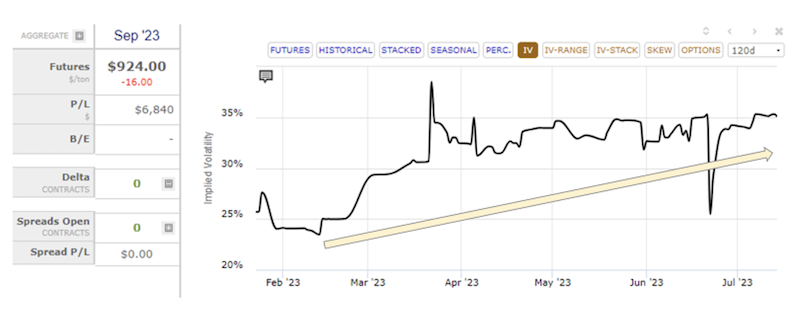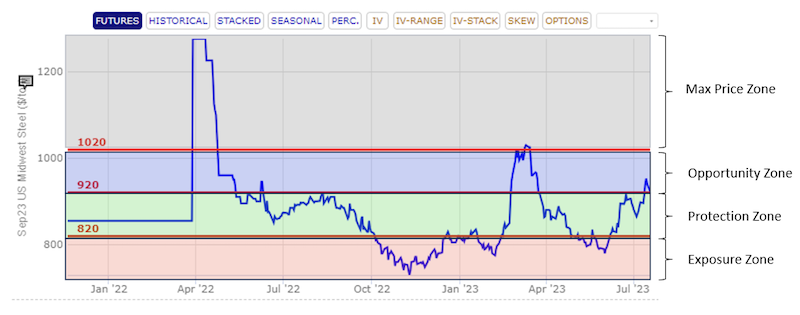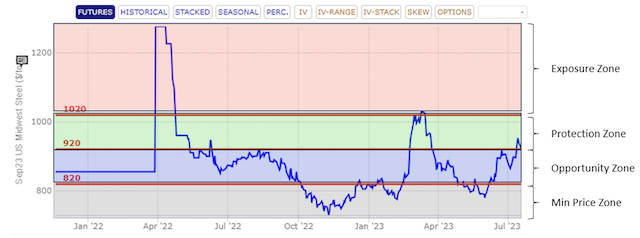Futures
HRC Futures: Volatility Leads Market Participants to Seek Flexibility
Written by Josh Pankratz & Logan Davis
July 20, 2023
In the past two months, the US Midwest Hot Rolled Coil (HRC) futures market has experienced significant fluctuations. The initial decline in prices led to destocking and low inventory levels. However, recent price increase announcements by mills halted the downward trend and even reversed it temporarily. The futures curve reflected short-term optimism but indicated that the market viewed the price hikes as a demand-pulling tactic rather than a long-lasting trend reversal as shown in the column by Flack Global Metals’ Daniel Doderer in SMU on June 29. The market has been volatile, influenced by factors such as elevated physical lead times, low consumer inventories, reshoring manufacturing, and fluctuating interest rates.
The recent activity suggests a pause in spot prices, with mills attempting to hold prices steady despite soft manufacturing data as shown in the column by Jack Marshall of Crunch Risk LLC in SMU on July 6. Import competition and selling interest from importers have impacted the market. The futures curve for Q3’23 HR average price reflects a slight increase, but the rest of the curve remains relatively flat. The market is likely to remain choppy and volatile in the coming weeks before a clearer direction emerges. The recent rally in August futures, accompanied by decreasing open interest, raises questions about the sustainability and commercial interest in the market, as shown in the July 13 column in SMU by David Feldstein, Rock Trading Advisors. The future trajectory of HRC prices is uncertain, and participants should approach the market with caution, as it has proven to be unpredictable and challenging to navigate.
With the uncertainty described in these recent news articles, it should be no surprise to hear that market participants would be prudent to seek flexibility. Fortunately, implied volatility levels would support the notion of selling options, facilitating the potential for a lower-cost strategy that could help traders buy time while the market shakes itself out. Implied Volatility is an essential element in an option’s price level, called premium. If volatility is high, the premium on the option tends to be relatively high. If volatility is low, the premium on the option tends to be relatively low.

When implied volatility is high, multi-leg option strategies can provide hedgers the ability to protect against a range of prices while also allowing for participation to beneficial price moves.
For example, a company with a large inventory balance— with risk to lower prices, might look to purchase a put option to place a floor on the inventory value. With implied volatility high, they could sell a lower strike put below that floor and a higher priced call option to reduce the cost of the protection. The resulting hedge position would look something like this:

Using US Midwest Hot-Rolled Coil options, the company would have a floor on their inventory value from $920 to $820, a price range where the market has shown some support this year. Additionally, from $920 up to $1,020, the company would participate in higher price on their inventory. They would be capped near year-to-date highs at $1,020. The strategy would cost about $20/ton, reducing the strategy cost by half vs. the put option on its own.
A similar strategy could be implemented for a company that has risk to higher prices. The major difference would be that the upside position would purchase a call option instead of a put. Buying the call would flip the above image upside down, but largely follow the same concept. Using the same strike prices as above, the company would have protection to the year-to-date highs previously discussed, and participation to the $820 level.

There is risk in futures and options trading. While the strategies above provide flexible protection at a low cost, there are considerations that must be made:
- Both the protection and participation elements of these strategies have limitations at different prices
- These strategies provide the potential for margin calls
- Offsetting before expiration will change the cost and P/L
When trading options, positions should be managed as the market changes and time passes.
Editor’s note: Want to learn more about steel futures? Attend the “Managing Price Risk Workshop” at our Steel Summit conference on Monday, Aug. 21, at 10 am. You can see the full agenda here and register here.
Disclaimer: Options pricing above based on theoretical values. There is a risk of loss in futures trading. Past performance is not indicative of future results. © 2023 Commodity & Ingredient Hedging, LLC. All rights reserved.
By Josh Pankratz and Logan Davis
Josh Pankratz is a Client Services manager for the Metals Team at CIH. With his focus on education, he helps clients effectively employ futures, options, and other contracting alternatives to manage their commodity price risk. Josh holds a Series 3 License and is a CFA charter holder.
Logan Davis is the Business Development manager for the Metals Team at CIH. He worked with CIH for five years on the client services side before returning to his family’s dairy operation to manage their commodity price risk along with the CIH Dairy team. Over the last year he has returned to present prospective metals clients with solutions to their price risk via CIH’s tools and services. Having been both a consultant and a client, Logan has a unique perspective on markets, risk, and the obstacles that both consultants and clients can encounter. Logan holds a Series 3 License.
About CIH:
Commodity & Ingredient Hedging is a technology enabled risk management firm that provides education and customized price risk management services to businesses impacted by volatility in commodities markets. The firm provides a structured, process driven methodology to help clients filter through the noise, digest what’s pertinent, and evaluate appropriate strategies. A personalized relationship with a CIH consultant provides consistent guidance designed to provide a focused and disciplined approach based on client objectives. We provide structure and education to implement a hedging plan that helps clients achieve their goals in managing profitability in the long term.”
Josh Pankratz
Read more from Josh Pankratz
Logan Davis
Read more from Logan DavisLatest in Futures

HR Futures: Summertime blues
Coming out of the holiday market and long weekend, it seems the HRC futures market has caught some post-vacation blues.

HR Futures: Financial players bullish on price, physical market participants not
We can interpret that managed money still has expectations of price strength while physical participants are running closer to a balance on a net basis.

HR Futures: Oil, Mideast tensions fail to move steel
After a hot start to June, the CME ferrous derivatives complex has cooled down.

HRC Futures: Could oil, ag price spikes drive steel higher too?
Could we see an abrupt shift now that oil prices have spiked higher? Will we see a rebound in the rig count? Will this create a snap-loading effect (think waterski rope), where the industry suddenly does a 180-degree turn? If so, will that bring with it increased demand for steel products used by the energy industry?

Flack: HR futures still on a wild ride
Never a dull moment in today's HR futures market.
